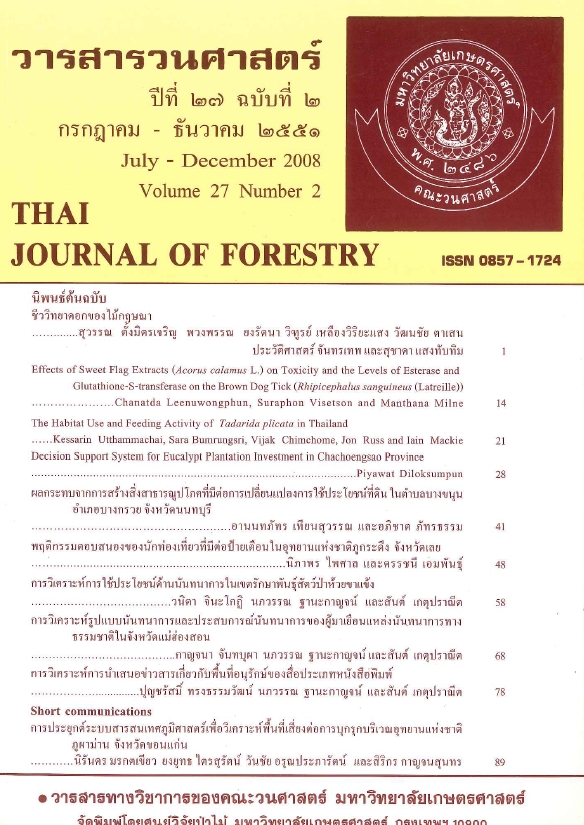ชีววิทยาดอกของไม้กฤษณา
Main Article Content
บทคัดย่อ
กฤษณาเริ่มออกดอกตั้งแต่ต้นเดือนมีนาคมและทยอยบานไปถึงเดือนพฤษภาคม ระยะดอกย่อย พัฒนาเป็นช่อดอกถึงระยะดอกพัฒนาเต็มที่และบานใช้เวลา 3 สัปดาห์ ดอกที่ไม่ได้รับการผสมเกสรหรือผสมไม่ติด จะร่วงภายใน 5 วัน ดอกเป็นแบบสมบูรณ์เพศ ประกอบด้วย หลอดกลีบเลี้ยง หลอดกลีบดอก วงเกสรเพศผู้ และวงเกสรเพศเมีย เรณูเป็นรูปทรงกลม ขนาดเส้นผ่าศูนย์กลาง 20-25 ไมครอน มีผนังแบบ gemmate ยอดเกสรเพศเมีย มีรูปร่างเป็นกระจุกกลม ยาว 0.7 มม. มีผิวขรุขระแบบ papillae ดอกเริ่มบานในช่วงเย็น ตั้งแต่เวลา 16.30 น ถึงเวลา 18.30 น แต่ส่วนใหญ่บานเต็มที่ เวลา 18.00 น เกสรต่างเพศในดอกเดียวกันแก่ไม่พร้อมกัน แบบ protandry ค่าเฉลี่ยจำนวนเรณูต่ออับเรณูของไม้กฤษณาคือ 1,937 และจำนวนเรณูต่อดอก (แต่ละดอกมี 10 อับเรณู) คือ 18,956 ค่าสัดส่วนของจำนวนเรณูต่อออวูล (P/O ratio) คือ 9,685.5 ซึ่งจัดว่ามีระดับการผสมข้ามสูง ที่เรียกว่า obligate xenogamy หรือกล่าวได้ว่า กฤษณาจำเป็นต้องได้รับการผสมข้ามในการสืบต่อพันธุ์ตามธรรมชาติ อัตราการติดผลตามธรรมชาติอยู่ในเกณฑ์ต่ำ (2.23%) และอัตราการติดผลของการผสมเกสรในตัวเอง พบว่า ไม่มีช่อดอกใดติดผลเลย ค่าความสำเร็จการสืบต่อพันธุ์ของกฤษณา มีค่าเฉลี่ยต่ำ คือเท่ากับ 0.05 โดยปรากฏการณ์ที่ดอกจำนวนน้อยที่สามารถเจริญพัฒนาไปเป็นผล แต่ออวูลส่วนใหญ่สามารถพัฒนาเป็นเมล็ดที่สมบูรณ์ บ่งชี้ว่าการร่วงหล่นของผลเกิดขึ้นในอัตราสูงกว่าการชะงักการเจริญเติบโตของเมล็ด
คำสำคัญ: กฤษณา การพัฒนาดอก ค่าสัดส่วนของจำนวนเรณูต่อออวูล การผสมเกสร ความสำเร็จของการสืบพันธุ์
Downloads
Article Details

อนุญาตภายใต้เงื่อนไข Creative Commons Attribution-NonCommercial-NoDerivatives 4.0 International License.
ข้าพเจ้าและผู้เขียนร่วม (ถ้ามี) ขอรับรองว่า ต้นฉบับที่เสนอมานี้ยังไม่เคยได้รับการตีพิมพ์และไม่ได้อยู่ในระหว่างกระบวนการพิจารณาตีพิมพ์ลงในวารสารหรือสิ่งตีพิมพ์อื่นใด ข้าพเจ้าและผู้เขียนร่วม (ถ้ามี) ยอมรับหลักเกณฑ์และเงื่อนไขการพิจารณาต้นฉบับ ทั้งยินยอมให้กองบรรณาธิการมีสิทธิ์พิจารณาและตรวจแก้ต้นฉบับได้ตามที่เห็นสมควร พร้อมนี้ขอมอบลิขสิทธิ์ผลงานที่ได้รับการตีพิมพ์ให้แก่วารสารวนศาสตร์ คณะวนศาสตร์ มหาวิทยาลัยเกษตรศาสตร์ กรณีมีการฟ้องร้องเรื่องการละเมิดลิขสิทธิ์เกี่ยวกับภาพ กราฟ ข้อความส่วนใดส่วนหนึ่ง หรือ ข้อคิดเห็นที่ปรากฏในผลงาน ให้เป็นความรับผิดชอบของข้าพเจ้าและผู้เขียนร่วม (ถ้ามี) แต่เพียงฝ่ายเดียว และหากข้าพเจ้าและผู้เขียนร่วม (ถ้ามี) ประสงค์ถอนบทความในระหว่างกระบวนการพิจารณาของทางวารสาร ข้าพเจ้าและผู้เขียนร่วม (ถ้ามี) ยินดีรับผิดชอบค่าใช้จ่ายทั้งหมดที่เกิดขึ้นในกระบวนการพิจารณาบทความนั้น”


